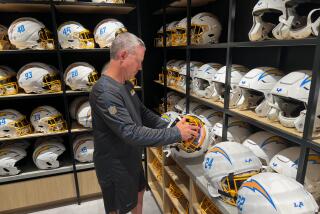COCAINE AND A SUPER BOWL TEAM: THE LAST STRAW : DRUGS IN THE NFL : A CHRONOLOGY
- Share via
1972--NFL Commissioner Pete Rozelle institutes a program with three aims: to educate, rehabilitate and discipline those involved with drugs.
1973--Dr. Arnold Mandel, an unofficial team psychiatrist for San Diego, admits dispensing 1,700 amphetamines to Charger players.
1974--The NFL fines the Chargers, their general manager and eight players for drug violations.
1975--Charlie Jackson is hired as assistant chief of league security, the first drug-oriented security officer in major professional sports.
1976--Miami goes from 10-4 in 1975 to 6-8, resulting in trades that owner Joe Robbie later says were designed to eliminate drug-users from the team.
1977--Miami Dolphins Don Reese and Randy Crowder are imprisoned for a year for selling cocaine.
1979--Dallas Cowboy wide receiver Bob Hayes, an Olympic gold medal sprinter, pleads guilty to narcotics charges and is sentenced to five years for selling cocaine to an undercover agent.
1980--Before the season, Minnesota sends quarterback John Reaves to Hazelden Rehabilitation Center in Center City, Minn.
January, 1981--Former Dallas linebacker Thomas (Hollywood) Henderson phones the NFL’s Jackson for help with a $1,200-per-day cocaine habit that has nearly forced him into bankruptcy. While receiving treatment, Henderson in February becomes the first player to publicly admit his involvement in drugs.
March, 1981--Former Minnesota defensive tackle Carl Eller checks into a chemical abuse center for treatment for a $2,000-per-week cocaine habit. Eller later joins the NFL’s drug-related security staff.
March, 1982--Viking quarterback Tommy Kramer spends 23 days at the CareUnit in Orange County. Teammate Randy Holloway spends 32 days at Hazelden.
April, 1982--St. Louis defensive end Kirby Criswell is arrested and later sentenced to five years in prison for conspiracy to make and distribute methamphetamines.
June, 1982--Cleveland running back Charles White undergoes treatment for cocaine and alcohol abuse at the CareUnit.
June 9, 1982--Linebacker Scott Studwell becomes the third Minnesota starter to undergo treatment, mainly for alcohol abuse, but Studwell also admits cocaine use.
June 12, 1982--Former New Orleans running back Mike Strachan is indicted on charges of selling and distributing cocaine, touching off a federal investigation of former and current Saints, at least a dozen of whom admit to purchasing the drug. Eight members of the 1982 Saints are questioned, including 1981 NFC Rookie of the Year George Rogers, who in July admits using cocaine and undergoes an extensive drug evaluation program.
June 14, 1982--Former Dolphin Reese, after undergoing treatment, recounts in a national sports magazine his escalating drug involvement in the five years since his arrest. He identifies teams--San Diego, New Orleans and Miami in particular--and players with drug problems, focusing on San Diego running back Chuck Muncie. The story is controversial, initially prompting denials and disclaimers, particularly from Muncie. But its impact is undeniable as players increasingly reveal their involvements and treatments.
July, 1982--Muncie checks into a detoxification center with a drug-alcohol problem.
December, 1982--As part of the collective bargaining agreement, Hazelden is designated as the NFL’s official employee assistance and rehabilitation center.
January, 1983--Former Miami star running back Eugene (Mercury) Morris is sentenced to 20 years in prison for cocaine trafficking and another five years for conspiracy.
February, 1983--St. Louis linebacker E.J. Junior pleads guilty to a charge of cocaine possession.
July, 1983--Rozelle suspends Junior and three other players, Cincinnati Bengals Pete Johnson and Ross Browner and Saint George Stemrick, without pay for the first four games of 1983 because of cocaine use.
Aug. 3, 1983--Washington All-Pro safety Tony Peters is arrested in his dormitory during training camp on cocaine charges, including conspiracy to distribute and is immediately suspended by the Redskins. After pleading guilty, Peters is given four-year suspended sentence, fined $10,000 and ordered to perform 500 hours of community service. On Nov. 18, Peters is suspended by the league for two seasons but is reinstated for 1984.
1983--Cleveland Coach Sam Rutigliano says eight Browns have a history of drug abuse problems and are being treated by rehabilitation and support programs offered by the team.
July, 1985--San Diego linebacker Mike Green is arrested for cocaine possession and enrolls in a drug treatment program with the agreement that the charge will be dropped if he goes six months without any further problems. Green plays all 1985 games.
September, 1985--Muncie misses team plane to Seattle and is traded a few days later to Miami. He flunks his urine test in Miami and is currently out of football.
Nov. 20, 1985--Kansas City defensive end Mike Bell is indicted on charges of use of a communications facility (telephone) to distribute cocaine and attempted possession of cocaine. Bell’s twin brother, Mark, a former pro football player, is indicted on the same charges. They plead innocent a week later and are awaiting trial.
Jan. 19, 1986--Cardinals’ owner Bill Bidwill tells players who refuse urinalysis as part of postseason physicals they’ll be fined $1,000. Most players refuse and are fined. Other teams, including Green Bay and New Orleans, follow suit and meet resistance from their players.
Jan. 27, 1986--The New England Patriots, one day after absorbing the worst defeat the Super Bowl’s 20-year history, agree to become the first NFL team voluntarily to agree to urine testing. Coach Raymond Berry says five players have serious drug problems and five to seven more are suspected of having a problem.
More to Read
Go beyond the scoreboard
Get the latest on L.A.'s teams in the daily Sports Report newsletter.
You may occasionally receive promotional content from the Los Angeles Times.










